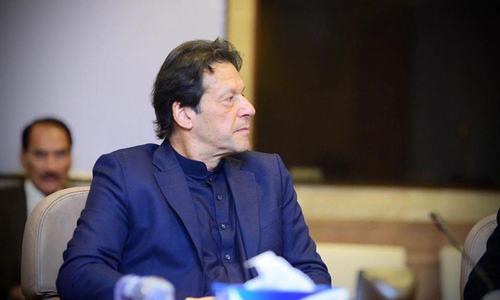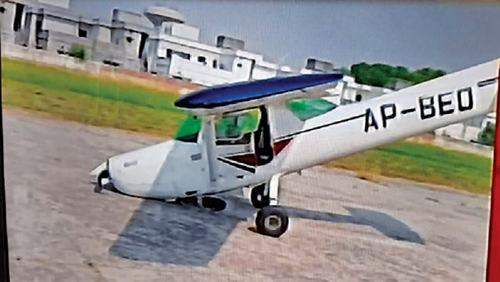AT the dead end of the Yasir Shaheed Road, off Ferozepur Road near Gulab Devi Hospital Chowk, Lahore Flying Club (Walton Airport) is huddled between Askari Flats and Falcon Complex. While the Walton Airport has survived the rigours of time since the 1930s, its resistance may not last long with the authorities apparently hand in glove with property developers having set their eyes on its prime land.
It was in the Shehbaz Sharif government in Punjab in 2013-14 when it was decided that one of the oldest airports of the country be closed and a business hub be launched in its place, Mohsin Syed, the Hybrid Aviation Ltd chairman who moved the court against the government plan and got a stay, tells Dawn. The case is still going on with more petitions added to it.
“The court gave us a stay immediately because the then government did not have any alternative plan to relocate the Lahore Flying Club. This government (of the PTI) expressed willingness to relocate the flying club along the Lahore-Sialkot Motorway outside the city. We agreed to the move on the conditions, including a certain length of the runway and day-and-night services. In the high court, the Civil Aviation Authority (CAA) agreed not to shut the Walton Airport until our relocation to the new site.”
According to Mohsin, four Hindu doctors had donated 30 acres of their personal property to launch the Northern India Flying Club in 1930 and got 256 acres land from the Government of Punjab, India, on lease. The Walton Airport (named after Sir Colonel Cusack Walton, who headed the flying club in 1935) was established over about 300 acres. In 1940, the British rulers acquired 1,000 acres from the forest department and local villagers before giving it to the Civil Aviation of India to establish a proper airport. The area included the land where now Main Boulevard of Gulberg, Mini Golf Course and Children’s Hospital are situated besides the land that’s now in possession of Pakistan Navy and Army. The airport still holds 400 to 500 acres of land.
British Wing Commander W.W. Russell, in his book Forgotten Skies; The Story of Air Forces in India and Burma, mentions the Walton Airfield, which housed the Initial Training School during the World War II where young Indians joining the Indian States Forces (ISF) as pilots were trained, showing that the facility has been a centre of training for pilots in the pre-Partition era. The practice continued with Pakistan Air Force (PAF) pilots after the Partition.
The Walton Airport had served as the airport of Lahore until 1962 when the Pakistan International Airlines included Boeing 720 in its fleet and the old airport could not accommodate the new fleet of aircraft. Currently, the Walton Airport not only provides training to pilots, but also serves as a training institute for related fields such as aeronautical engineering and aviation management.
Mohsin, a professional pilot with a degree in Chemical Engineering, launched Hybird Aviation in 1998 with two aircraft. Now it has 11 aircraft, a flying school and various other facilities related to aviation. Besides Hybrid Aviation, the Walton Airport has five organisations providing aviation and flying services, including Ultralight and Sports Flying Club and Airborne Aviation Flying School. Another organisation assembles and manufactures aircraft. The Lahore Flying Club has about 50 aircraft with the claim to be the biggest flying school of Pakistan. “Our trained pilots are flying Airbus A380 in the Emirates,” Mohsin says, expressing the fear that the largest flying school closure without proper relocation would eventually result in closure of airlines in the country.
Flying clubs and aviation had suffered a blow in 2015 when a policy shift resulted in the shutdown of almost all flying clubs in the country.
Almost 200 pilots along with as many aviation engineers are trained here at the Walton Airport. Many private varsities are running aviation programmes, as UMT, Superior University, and University of Lahore and Institute of Space Technology in Islamabad send students for training and internship here. “The students get three-year training on grounded aircraft as well as flying aircraft. We produce about 60 pilots annually,” Mohsin claims.
Nimra Faisal, who has just completed her BS in Aviation Management, says she went to the Walton Airport for three years during her studies to get training, as airfield was essential part of her programme. She says students could not do training without simulation facility that was available only at the Walton Airport.
The government announced the closure of the Walton Airport and Lahore Flying Club on April 28, a couple of months after promulgating the Lahore Central Business District Development Authority Ordinance 2021 to develop a business hub on the club land.
Mohsin believes the airport closure plan is based on mala fide intention and its notification was issued to pave the way for an Abu Dhabi firm constructing a plaza opposite Qaddafi Stadium on Ferozepur Road. The skyscraper will be about 500 feet tall, whereas no building near the Walton Airport could go beyond 150-foot height.
Amid fears that the prime land might be given at cheap rates to government’s blue-eyed persons who would resell it at commercial rates, he suggests there should be an open auction for the land after airport’s relocation and a part of the earning should go to the Lahore Flying Club and other stakeholders, including owners of the land which had been acquired in the 1950s for the purpose of airport expansion. He demands the government first ensure relocation of the flying club to the new site with all facilities before the Walton Airport closure and enough compensation to all the stakeholders. “The Lahore Flying Club owns the land in the airport, it has buildings and hangers. It has right of flying club to be a part of negotiations regarding the Walton Airport happening between the federal and provincial governments,” he asserts.
Published in Dawn, May 17th, 2021















































